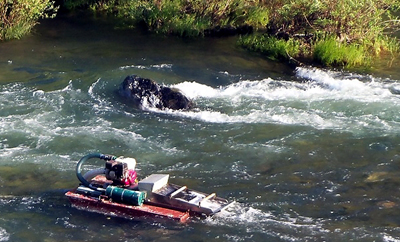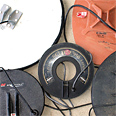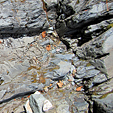Prospecting & Detecting
California to Allow Suction Dredging in 2019?
June 2018 by Scott Harn
Back in August, 2009, the California legislature passed SB 670, which was the first ban on suction gold dredging in the state. The bill, written by the Sierra Fund, mandated a temporary moratorium on suction gold dredging until a new environmental study could be completed by the California Department of Fish and Game.
California Senate Bill 637, which took effect January 1, 2016, redefined what qualified as a suction dredging device and transferred authority over suction dredging to the California State Water Resources Control Board and directed the agency
The American Mining Rights Association (AMRA) made presentations at public hearings conducted by the California State Water Resources Control Board regarding suction gold dredging as the agency attempted to dive into this issue. I viewed one of these presentations by AMRA’s Shannon Poe. He—along with many other suction dredgers—did a very good job in presenting the facts and educating Board members.
 In April of this year, Poe met with members of the California Senate Natural Resources Committee over another bill, SB 1222. He was concerned this bill would have made many other types of mining equipment off-limits. This started up a much needed dialogue with members of the legislature.
In April of this year, Poe met with members of the California Senate Natural Resources Committee over another bill, SB 1222. He was concerned this bill would have made many other types of mining equipment off-limits. This started up a much needed dialogue with members of the legislature.
In a recent Facebook post, Poe stated that suction gold dredging will be returning to California in 2019.
I reached out to him to try to get some clarification just prior to our press time, but he responded that he was going to be unavailable and up in the mountains for several days.
If this becomes a reality, it could be very welcome news if under the right circumstances. The post was very well read and I’m confidant environmental groups read it as well.
First, let’s take a look at a few excerpts from the news he posted:
As a part of SB637 (the Suction Dredge Bill) signed into law in January of 2016, it was mandated that the California Water Board (CAWB) study and evaluate whether permitting should be allowed in the state, and if so, the CAWB was tasked with creating a permitting structure. We believe the sponsors of SB637, Izzy Martin and the enviro group The Sierra Fund, along with their Senator who brought the bill forward, Ben Allen, a Democrat from Hollywood, believed the CAWB would toe the political line and just slow walk or deny permits all along. SB 637 morphed into a de facto prohibition on mining as it then labeled all things as suction dredges [including] high bankers, water pumps, track wheel chairs, trucks and even sluice boxes. People were cited, their equipment confiscated and fines were paid. We pointed out that this morphing of language was illegal, immoral and adversely affected 10’s of thousands of people. Kind of hard to say an airplane is a wheelbarrow just because both have wheels and that is precisely what the vague language in SB637 did. They stated “you can still pan”.
As we pointed out in testimony at the Senate hearing on SB1222, panning is not, nor has it ever been a mining method. It is a final process, but not a mining method. Therefore, since that was really all they left us with, we made that argument, which was quite compelling that this is a ban and an illegal prohibition on small-scale mining.
So the CAWB didn’t toe the political line as some expected. What happened is the folks at the CAWB who are scientists and engineers pulled the raw data of all the studies over the past 20 years which were provided to them by WMA (Western Mining Alliance) and decided to see if dredging was in fact harming fish or fish habitat. What they concluded was dredging was de minimus, meaning it doesn’t harm fish or fish habitat. Their Board of Directors voted unanimously it is de minimus (no harm). We attended and presented (on your behalf) at every one of the public hearings with the CAWB when the permitting was being discussed and we produced a pretty compelling video of the Department of Fish and Game (DFG) actively suction dredging in other states to “create fish habitat”. Let that sink in for a minute….other states are dredging to “create” fish habitat. How is it that other states dredge to create fish habitat, but California thinks it kills fish? Well, it is because this is all political and not scientific (like you guys didn’t know that…). So what happened is they didn’t take Craig’s [from WMA] word for what the outcome was on all these studies, they pulled the raw data and then over the next year, AMRA worked with them on a permitting structure and we did this quietly and behind the scenes. If you recall, the DFG created a nightmare proposal on dredging, the one we recommended was nothing like that. It was one that didn’t involve keeping a diary, waiting a year for a permit or costing 5 grand to run a 4” dredge while being limited to a small 20 foot area in a creek they chose. CAWB listened and while ultimately it was their decision on what permitting structure to go with, it is nothing like we feared.
Over the past week we have been in meetings, had calls and emails too numerous to list asking questions we know you’d be asking because hell, they are what we would want to know as we are miners through and through like many of you. Most questions we can answer now, some we cannot answer until late June when we have some formal meetings with the Director of the CAWB and a few Senators, but we are in fact going to be dredging next spring. It will be nearly impossible for the CAWB to pull back this acknowledgment that dredging will be permitted next year.
So, here’s the nuts and bolts:
Firstly, almost all of the equipment wrapped up in the vague language of SB637 is being reversed and will once again be legal and not considered a suction dredge.
High bankers are one piece of equipment we are still actively discussing and may involve a permit of some kind if run in the creek. We believe strongly since this is incidental fallback, like a dredge, it adds nothing and does not cause any adverse impacts on California waterways. Science should prevail, not emotion or how someone feels it might, may, could or potentially impact a waterway. Facts and science.
Permitting applications will be available in early Spring and we are shooting for the very first day of Spring which is March 20, 2019.
Why does it take this long, well this whole process was in fact ready to go last summer and the permitting structure was created, written and was ready for public comment, then the Director of the Water Board was replaced. The new Director, appointed by Governor Brown stopped all progress on the permits. SB637 had a mandate of 1 year for the CAWB to come up with a plan and they are now at 2 years, 4 months and 16 days. That is not just unacceptable, it is in violation of the law and we made sure they knew that.
What remains now in the process is the public comment period where they tell the public what they plan to do and ask for comments. We expect you all to provide input.
Cost: It is not going to be $2,000 like someone posted on FB, that is incorrect. The permit costs we expect to be around $200 or close to it. They have a calculation where the permit structure needs to be 110% of the cost to do the permits so it shouldn’t be that much.
It will be an on-line application process meaning you go to a specific link at the CAWB and fill it out on your computer.
It should take no more than 3 or 4 weeks for the permit, but we are going to see if this can be sped up like the Ag permits farmers obtain routinely and rapidly.
The permits are good perpetually, meaning that you pay for the permit in 2019, then if you want to dredge next year, you do not have to re-apply, just pay the fee and go dredge.
I dredge multiple rivers, do I need a permit for each waterway?
No, one permit for the whole state.
Do studies have to be done for the creek I want to dredge?
No. There will be no site specific studies required for any permits.
Will I need to get a DFG permit like we did in 2009 in addition to the CAWB permit?
No. Department of Fish and Game, who [we were] required to obtain a permit from, will be eliminated. No permits will be required from DFG for suction dredging.
Who enforces this?
DFG will be the enforcement arm and will be the agency tasked with checking for permits like we all remember…although in decades of dredging with a permit, I never once got checked.
Do we have to keep silly diaries and all the other documentation like what was proposed before?
No. There are no after season, nor continual season reporting requirements like DFG proposed in 2012 like keeping a diary and all that nonsense.
_______________
There are a few things still unanswered like:
Are there restrictions on sizes of dredges and motors. We believe dredging will be handled like it was prior to the moratorium in 2009, but do need this in writing before making a statement.
What specific rivers/waterways will have a season, although it appears as it is exactly like it was in 2009. No dredging during spawning season (which we support).
We also do not know the specific regulations to a fine detail. However the CAWB has specifically stated they would like AMRA (Shannon Poe) to help them with the language and make sure the language does not encompass other equipment like the vague SB637.
So as you can see, this is monumental. We are going to obtain this in writing shortly and you have our sincere promise that we will be working with them daily if necessary. They have made these statements in front of two sitting California Senators. It would be close to impossible for them to back out of this without some severe exposure to a lawsuit….and bring one we would on your behalf.
We know you’ll have questions, and if we can answer them, we will, if we cannot, we will get them.
_______________
First off, I want to applaud AMRA for their efforts. They spent a lot of time and effort on this. There are plenty of miners who have been anxiously awaiting the chance to get back to work. I began dredging in 1983, and include myself in that group. It’s an efficient and environmentally sound method to recover gold and other heavy metals—including mercury—that pollute our rivers and streams.
Second, I want to mention a few concerns I have. I mentioned the Facebook post was well read, which certainly includes environmental groups, and he states he hopes to get some things finalized during upcoming meetings in late June. It would have been beneficial to hold off the announcement until after those meetings and specific commitments were made on the record and in writing.
My biggest concerns are related to the regulations and permitting process itself. California began regulating dredging in 1961, following a report by the Department of Fish and Game that recommended some restrictions to prevent harm to salmon spawning areas. This report recommended nozzle sizes be limited to 8 inches. Permits were not mandatory.
In the early 1980s, there were nearly 13,000 suction gold dredgers in California.
In 1994, Fish and Game completed an environmental impact report (EIR) and instituted restrictions on times, locations and the size of equipment used. Some miners reluctantly went along with the new requirements in order to continue working, but environmental groups were far from being satisfied; they were already working on the next step.
Many serious miners could no longer make a living with the new restrictions on nozzle sizes, locations and work windows. According to the Western Mining Alliance, the average number of dredge permits issued per year after 1994 plummeted to only 3,600.
When the status of Coho salmon was changed from “species of special concern” to “threatened,” environmental groups saw an opening to contest the previous EIR.
In 2005, environmental groups recruited the Karuk tribe in northern California and assisted them with a lawsuit to force a new EIR. Public Lands for the People and the New 49er’s learned of an impending settlement between the Karuks and Fish and Game and they intervened.
A second lawsuit resulted in a judge’s order to conduct a new EIR. And then along came the legislature to back up the environmental groups.
Every California dredger knows what happened next. A new EIR was completed that relied heavily on one flawed study by Charlie Alpers of the USGS. Mr. Alpers dug a hole in the bank of a river in the worst known mercury hotspot in the state and utilized a recirculating system that wasn’t remotely equivalent to a suction dredge to help him reach the conclusion he desired—there’s too much mercury that could be stirred up to allow dredging. And Mr. Alpers forgot to mention at the time he was on the board of advisors for the Sierra Fund.
We’ve been prevented from working federal mining claims ever since by a permitting scheme run by a state that requires permits but refuses to issue them.
What we are talking about here is the right of self-initiation and mining rights set forth by the 1872 Mining Law and subsequent mining laws. Federal law preempts state law, and federal law says that no permit under the Clean Water Act is necessary unless there is the addition of a pollutant. In fact, suction gold dredging creates a net withdrawal, and what you are removing is gold and heavy metals that might be present, which provides a benefit to the state.
There are a few questions you will need to ask yourself before you apply for a suction dredge permit from the State Water Resources Control Board.
- Are you willing to concede you are discharging a pollutant under the Clean Water Act, even though that’s not the case?
- Are you willing to pay a fee as if you are a polluter?
- Are you willing to allow the State of California to dictate the nozzle size, location, and time of your operation?
- Would you be better off utilizing your traditional, organized Mining District to create a jurisdictional problem for state agencies and negotiate reasonable work windows, locations and equipment?
- Are you willing to give up your mining rights to some of the best gold-bearing rivers and streams when the state decides to place them off-limits?
- Have you considered supporting the “Small Miner Amendments to S 145”, which would remove states from authority over dredging without giving up your rights?
- Can you actually make a living with these restrictions?
- Is the agency violating your rights to mine your federal mining claim because of these restrictions even if permits are issued?
I know these are tough questions and you are anxious to get back to dredging, but is suction gold dredging really mining when you’re subjecting yourself to the rules and regulations of a “recreational” user of public lands rather than a federal mining claim holder?
There are many unanswered questions, and I'm sure AMRA can help with some answers when time allows.
Search Coils and Techniques
 This article is intended to try to help someone who is breaking into gold detecting and using a pulse induction (PI) detector.
This article is intended to try to help someone who is breaking into gold detecting and using a pulse induction (PI) detector.
Searchers' Dreams
The story began in a southern Arizona mountain range...
Why Is The Gold On Bedrock—Or Why Is It Not?
 Gold on the bedrock is a good rule of thumb, but not one that is 100 percent effective. There are plenty of exceptions. So, how does a prospector recognize those exceptions?
Gold on the bedrock is a good rule of thumb, but not one that is 100 percent effective. There are plenty of exceptions. So, how does a prospector recognize those exceptions?
12-Year-Old Unearths Large Diamond
It is the eighth largest brown diamond to be found and certified by park staff.
Metallic Trash—Scourge of the Prospector
 I had been busy representing the Prospecting and Mining Journal this spring, but prospecting season finally arrived and I’ve been out digging for nuggets—I’ve even found a few. I know a number of prospectors who are armed with new metal detectors and headed to the hills to look for that precious yellow stuff.
I had been busy representing the Prospecting and Mining Journal this spring, but prospecting season finally arrived and I’ve been out digging for nuggets—I’ve even found a few. I know a number of prospectors who are armed with new metal detectors and headed to the hills to look for that precious yellow stuff.
Cold Water Gold
It was June 2011, and my wife Fran and I with Grandson Lucas and good friend Ernie Cruz were attempting to get to our gold mining claim on the Middle Fork of the Feather River about ten miles from Quincy, California. Rain had poured down in the previous few days and the road in a large number of low places was under water. Following two hours of slugging through the mud...
Our Readers Say
• Prospecting for Diamonds in Kimberlite by W. Dan Hausel
• Miners referring to their activity as “recreational”
Subscription Required:
The Bawl Mill
• Legislative and Regulatory Update
• Ask The Experts - Are there different “ferro” products processed out of the ore?
• Ask The Experts - How hot does a furnace need to be to get rid of sulphides?
• Ask The Experts - Will this paystreak be downriver off the trailing edge of bedrock?
• Putting Together A Small Free Gold Mill—Part II
• Chasing Float Gold—The Starry Night Wash
• 2018 National Mining Hall of Fame Inductees
• A Test Grid Dredged for Gold Values
• Michigan House Votes to Give Mining Operations More Flexibility
• Mineral Exploration On The Rise
• 18 Acquitted in Massive Brussels Diamond Heist
• Captain Obvious Strikes Again
• Melman on Gold & Silver
• Mining Stock Quotes and Mineral & Metal Prices
Free:
PLP Update








